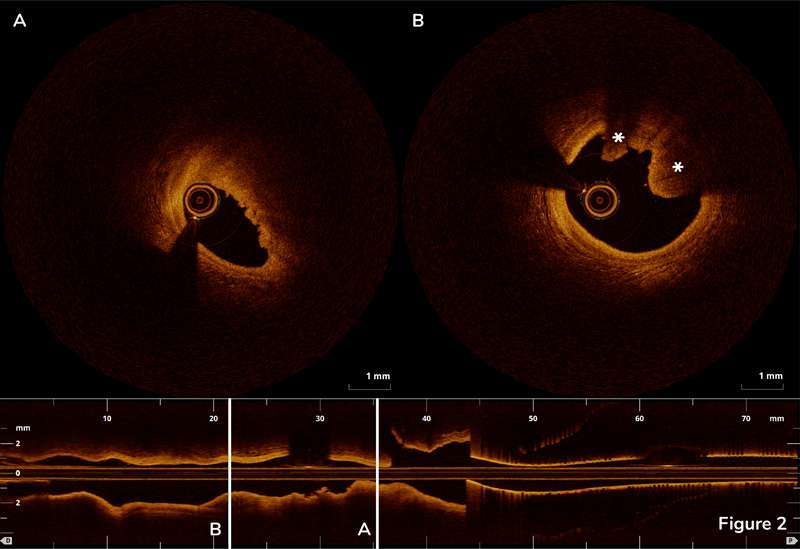Plaque Erosion in a Young Patient with NSTEMI
A 34-year-old man, current smoker with a history of autoimmune hepatitis, who underwent liver transplantation 5 years earlier, presented with NSTEMI. Coronary angiography revealed a 70-80% culprit lesion in the proximal LAD (Figure 1, arrow) and a filling defect downstream (Figure 1, arrowhead).
Post-stent OCT demonstrated optimal stent expansion with MSA=9.6 mm2 (Figure 4A). Significant stent malapposition (axial distance > 0.4 mm for 2 mm of longitudinal length), was detected in the proximal stent edge extending to the distal LM (Figure 4B, arrows and Figure 4C, red stent struts). Based on the findings, the operator performed post-dilatation with a 5.0×8.0 mm NC Emerge.TM
Cardiovascular complications and metabolic alterations are responsible for substantial morbidity and mortality during early and long-term follow-up among liver transplantation recipients.1 Plaque erosion is an increasingly recognized etiology of ACS accounting up to one-third of the acute events. Plaque erosion is considered to be definite in the absence of fibrous cap disruption with overlying white thrombus. OCT is the only intravascular image modality that is known to be successful in diagnosing plaque erosion. Identification of plaque erosion may facilitate tailoring of patient treatment. A small proof-of-concept study of 60 patients demonstrated that plaque erosion associated with a residual diameter stenosis less than 70% may be treated conservatively, with anti-thrombotic and anti-platelet therapy, allowing avoidance of stent deployment.2
- Persaud A, Ahmed A, Kakked G, Shulik O, Ahlaw S. Cardiovascular and Metabolic Consequences of Liver Transplantation: A Review. Digestive and Liver Disease Volume 51, Issue 11, Pages 1604-1609
- Jia H, Dai J, Hou J, Xing L, Ma L, Liu H, Xu M, Yao Y, Hu S, Yamamoto E, Lee H, Zhang S, Yu B, Jang I-K. Effective anti-thrombotic therapy without stenting: intravascular optical coherence tomography-based management in plaque erosion (the EROSION study). Eur Heart J 2017;38:792–800
















